
Pre-dreadnought
Encyclopedia
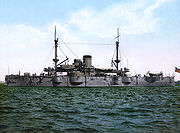
.jpg)
Battleship
A battleship is a large armored warship with a main battery consisting of heavy caliber guns. Battleships were larger, better armed and armored than cruisers and destroyers. As the largest armed ships in a fleet, battleships were used to attain command of the sea and represented the apex of a...
s built between the mid-1890s and 1905. Pre-dreadnoughts replaced the ironclad
Ironclad warship
An ironclad was a steam-propelled warship in the early part of the second half of the 19th century, protected by iron or steel armor plates. The ironclad was developed as a result of the vulnerability of wooden warships to explosive or incendiary shells. The first ironclad battleship, La Gloire,...
warships of the 1870s and 1880s. Built from steel, and protected by hardened steel armour, pre-dreadnought battleships carried a main battery
Main battery
Generally used only in the terms of naval warfare, the main battery is the primary weapon around which a ship was designed. "Battery" is in itself a common term in the military science of artillery. For example, the United States Navy battleship USS Washington had a main battery of nine guns...
of very heavy guns in barbettes (open or with armored gunhouses) supported by one or more secondary batteries of lighter weapons. They were powered by coal-fuelled triple-expansion steam engines.
In contrast to the chaotic development of ironclad warships in preceding decades, the 1890s saw navies worldwide start to build battleships to a common design as dozens of ships essentially followed the design of the British Majestic
Majestic class battleship
The Majestic class was a class of pre-dreadnought battleships, built under the Spencer Programme of 8 December 1893, that sought to counter the growing naval strength of France and the Russian Empire...
class. The similarity in appearance of battleships in the 1890s was underlined by the increasing number of ships being built. New naval powers such as Germany
German Empire
The German Empire refers to Germany during the "Second Reich" period from the unification of Germany and proclamation of Wilhelm I as German Emperor on 18 January 1871, to 1918, when it became a federal republic after defeat in World War I and the abdication of the Emperor, Wilhelm II.The German...
, Japan
Empire of Japan
The Empire of Japan is the name of the state of Japan that existed from the Meiji Restoration on 3 January 1868 to the enactment of the post-World War II Constitution of...
, and the United States began to establish themselves with fleets of pre-dreadnoughts, while the navies of Britain
United Kingdom of Great Britain and Ireland
The United Kingdom of Great Britain and Ireland was the formal name of the United Kingdom during the period when what is now the Republic of Ireland formed a part of it....
, France
French Third Republic
The French Third Republic was the republican government of France from 1870, when the Second French Empire collapsed due to the French defeat in the Franco-Prussian War, to 1940, when France was overrun by Nazi Germany during World War II, resulting in the German and Italian occupations of France...
, and Russia
Russian Empire
The Russian Empire was a state that existed from 1721 until the Russian Revolution of 1917. It was the successor to the Tsardom of Russia and the predecessor of the Soviet Union...
expanded to meet these new threats. The decisive clash of pre-dreadnought fleets was between the Russians
Imperial Russian Navy
The Imperial Russian Navy refers to the Tsarist fleets prior to the February Revolution.-First Romanovs:Under Tsar Mikhail Feodorovich, construction of the first three-masted ship, actually built within Russia, was completed in 1636. It was built in Balakhna by Danish shipbuilders from Holstein...
and Japanese
Imperial Japanese Navy
The Imperial Japanese Navy was the navy of the Empire of Japan from 1869 until 1947, when it was dissolved following Japan's constitutional renunciation of the use of force as a means of settling international disputes...
during the Battle of Tsushima
Battle of Tsushima
The Battle of Tsushima , commonly known as the “Sea of Japan Naval Battle” in Japan and the “Battle of Tsushima Strait”, was the major naval battle fought between Russia and Japan during the Russo-Japanese War...
on 27 May 1905.
These battleships were abruptly made obsolete by the arrival of HMS Dreadnought
HMS Dreadnought (1906)
HMS Dreadnought was a battleship of the British Royal Navy that revolutionised naval power. Her entry into service in 1906 represented such a marked advance in naval technology that her name came to be associated with an entire generation of battleships, the "dreadnoughts", as well as the class of...
in 1906. Dreadnought followed the trend in battleship design to heavier, longer-ranged guns by adopting an "all-big-gun" armament scheme of ten 12 inches (305 mm) guns
BL 12 inch Mk X naval gun
The BL 12 inch Gun Mark X was a British 45-calibres naval gun which was mounted as primary armament on battleships and battlecruisers from 1906...
; her innovative steam turbine
Steam turbine
A steam turbine is a mechanical device that extracts thermal energy from pressurized steam, and converts it into rotary motion. Its modern manifestation was invented by Sir Charles Parsons in 1884....
engines also made her faster. The existing pre-dreadnoughts were decisively outclassed; new battleships were from then on known as dreadnought
Dreadnought
The dreadnought was the predominant type of 20th-century battleship. The first of the kind, the Royal Navy's had such an impact when launched in 1906 that similar battleships built after her were referred to as "dreadnoughts", and earlier battleships became known as pre-dreadnoughts...
s while the ships laid down previously were designated pre-dreadnoughts. In spite of their obsolescence, the pre-dreadnought battleships played an important role in World War I and could even be found serving in World War II.
Evolution

Ironclad warship
An ironclad was a steam-propelled warship in the early part of the second half of the 19th century, protected by iron or steel armor plates. The ironclad was developed as a result of the vulnerability of wooden warships to explosive or incendiary shells. The first ironclad battleship, La Gloire,...
. The first ironclads—La Gloire
French battleship La Gloire
The French Navy's La Gloire was the first ocean-going ironclad battleship in history.She was developed following the Crimean War, in response to new developments in naval gun technology, especially the Paixhans guns and rifled guns, which used explosive shells with increased destructive power...
and Warrior
HMS Warrior (1860)
HMS Warrior was the first iron-hulled, armour-plated warship, built for the Royal Navy in response to the first ironclad warship, the French Gloire, launched a year earlier....
—looked much like a sailing frigate
Frigate
A frigate is any of several types of warship, the term having been used for ships of various sizes and roles over the last few centuries.In the 17th century, the term was used for any warship built for speed and maneuverability, the description often used being "frigate-built"...
, with three tall masts and broadside
Broadside
A broadside is the side of a ship; the battery of cannon on one side of a warship; or their simultaneous fire in naval warfare.-Age of Sail:...
battery, when they were commissioned at the start of the 1860s. Only eight years later HMVS Cerberus
HMVS Cerberus
HMVS Cerberus is a breastwork monitor that served in the Victoria Naval Forces, the Commonwealth Naval Forces , and the Royal Australian Navy between 1871 and 1924....
, the first breastwork monitor
Breastwork monitor
A breastwork monitor was one of a number of ships designed by Sir Edward Reed, the Chief Constructor of the Royal Navy between 1863 and 1870....
, was launched. Only three years later followed HMS Devastation
HMS Devastation (1871)
HMS Devastation was the first of two Devastation-class mastless turret ships built for the British Royal Navy. This was the first class of ocean-going capital ship that did not carry sails, and the first whose entire main armament was mounted on top of the hull rather than inside it...
, a turret ironclad which more resembled a pre-dreadnought than previous and contemporary turretless ironclads. Mastless, both ships carried four heavy guns in two turrets fore and aft. Devastation was the first ocean-worthy breastwork monitor, built to attack enemy coasts and harbours; because of her very low freeboard
Freeboard (nautical)
In sailing and boating, freeboardmeans the distance from the waterline to the upper deck level, measured at the lowest point of sheer where water can enter the boat or ship...
, she could not fight on the high seas as her decks would be swept by water and spray, interfering with the working of her guns. Navies worldwide continued to build masted, turretless battleships which had sufficient freeboard and were good enough to fight on the high seas.
The distinction between coast-assault battleship and cruising battleship became blurred with the Admiral
Admiral class battleship
The British Royal Navy's pre-dreadnought Admiral class battleships of the 1880s followed the pattern of the Devastation class in having the main armament on centre-line mounts with the superstructure in between. This pattern was followed by most following British designs until in 1906...
class, ordered in 1880. These ships reflected developments in ironclad design, being protected by iron-and-steel compound armour
Compound armour
Compound armour was a type of armour used on warships in the 1880s. By the end of the decade it had been rendered obsolete by nickel-steel armour.-Prior armours:...
rather than wrought iron
Wrought iron
thumb|The [[Eiffel tower]] is constructed from [[puddle iron]], a form of wrought ironWrought iron is an iron alloy with a very low carbon...
. Equipped with breech-loading guns of between 12-inch and 16 ¼-inch (305 mm and 413 mm) calibre, the Admirals continued the trend of ironclad warships towards gigantic weapons. The guns were mounted in open barbette
Barbette
A barbette is a protective circular armour feature around a cannon or heavy artillery gun. The name comes from the French phrase en barbette referring to the practice of firing a field gun over a parapet rather than through an opening . The former gives better angles of fire but less protection...
s to save weight. Some historians see these ships as a vital step towards pre-dreadnoughts; others view them as a confused and unsuccessful design.

Royal Sovereign class battleship
The Royal Sovereign class was a class of pre-dreadnought battleships of the British Royal Navy. The class comprised seven ships built to the same design: HMS Royal Sovereign, , HMS Ramilles, HMS Repulse, HMS Resolution, HMS Revenge, and HMS Royal Oak, and a half-sister built to a modified design: ....
class of 1889 retained barbettes but were uniformly armed with 13.5 inches (343 mm) guns
BL 13.5 inch naval gun Mk I - IV
The BL 13.5 inch naval gun Mk I was Britain's first successful large breechloading naval gun. Mks I - IV were all of 30 calibres length and of similar construction and performance.-Royal Navy service:...
; they were also significantly larger (at 14,000 tons displacement
Displacement (fluid)
In fluid mechanics, displacement occurs when an object is immersed in a fluid, pushing it out of the way and taking its place. The volume of the fluid displaced can then be measured, as in the illustration, and from this the volume of the immersed object can be deduced .An object that sinks...
) and faster (due to triple-expansion steam engines) than the Admirals. Just as importantly, the Royal Sovereigns had a higher freeboard, making them unequivocally capable of the high-seas battleship role.
The pre-dreadnought design reached maturity in 1895 with the Majestic
Majestic class battleship
The Majestic class was a class of pre-dreadnought battleships, built under the Spencer Programme of 8 December 1893, that sought to counter the growing naval strength of France and the Russian Empire...
class. These ships were built and armoured entirely of steel, and their guns were mounted in fully enclosed barbettes, inevitably referred to as turrets. They also adopted a 12 inches (305 mm) main gun
BL 12 inch naval gun Mk VIII
The BL 12 inch naval gun Mark VIII was one of the first large British naval guns designed for the higher pressures generated by the new cordite propellant, and Britain's first large wire-wound gun...
, which, due to advances in casting and propellant, was lighter and more powerful than the previous guns of larger calibre. The Majestics provided the model for battleship building in the Royal Navy and many other navies for years to come.
Armament
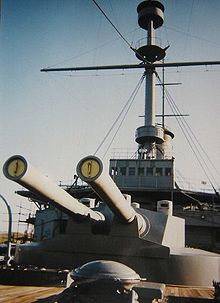
The most common calibre for the main armament was 12 inches, although some ships used smaller guns because they could attain higher rates of fire; British battleships from the Majestic class onwards carried this calibre, as did French ships from the Charlemagne class (laid down in 1894). Japan, importing most of its guns from Britain, used 12-inch guns. The United States used both 12- and 13 inches (330 mm) guns for most of the 1890s until the Maine
Maine class battleship
The three Maine class battleships: , , and were launched in the first several years of the 20th century. These were the first US capital ships to use smokeless powder for their main batteries, and the last to use Harvey armor. Smokeless powder allowed a decrease in gun size, with an increase in...
class, laid down in 1899, after which the 12 inches (305 mm) gun was universal. The Russians used both 12- and 10 inches (254 mm) as their main armament; the Petropavlovsk class, Retvizan, Tsesarevich, and Borodino class had 12 inches (305 mm) main batteries while the Peresviet class
Peresviet class
The Peresvet-class were pre-dreadnought battleships of the Imperial Russian Navy. All three ships were lost by the Russians in the Russo-Japanese war. One ship was sunk at the Battle of Tsushima and two were captured after being sunk during the Siege of Port Arthur.-Design:These ships were inspired...
mounted 10 inches (254 mm) guns. The first German pre-dreadnought class used a 11 inches (279 mm) gun but decreased to a 9.4 inches (239 mm) gun for the two following classes and returned to 11-inch guns with the Braunschweig
Braunschweig class battleship
The Braunschweig class battleships were pre-dreadnought battleships of the Kaiserliche Marine . The class comprised five ships: , , , , and...
class.
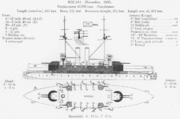
_profile_drawing.png)
Nitrocellulose
Nitrocellulose is a highly flammable compound formed by nitrating cellulose through exposure to nitric acid or another powerful nitrating agent. When used as a propellant or low-order explosive, it is also known as guncotton...
and cordite
Cordite
Cordite is a family of smokeless propellants developed and produced in the United Kingdom from 1889 to replace gunpowder as a military propellant. Like gunpowder, cordite is classified as a low explosive because of its slow burning rates and consequently low brisance...
propellant meant a longer barrel, and therefore higher muzzle velocity
Muzzle velocity
Muzzle velocity is the speed a projectile has at the moment it leaves the muzzle of the gun. Muzzle velocities range from approximately to in black powder muskets , to more than in modern rifles with high-performance cartridges such as the .220 Swift and .204 Ruger, all the way to for tank guns...
—giving greater range and penetrating power for the same calibre of shell. Between the Majestic class and Dreadnought, the length of the British 12-inch gun increased from 35 calibres to 45 and muzzle velocity increased from 2417 feet per second (737 m/s) to 2725 (830 m/s).
Pre-dreadnoughts also carried a secondary battery. This consisted of smaller guns, typically 6 inches (152 mm), though any calibre from 4 to 9.2 inches (100 to 230 mm) could be used. Virtually all secondary guns were "quick firing
Quick-firing gun
A quick-firing gun is an artillery piece, typically a gun or howitzer, which has several characteristics which taken together mean the weapon can fire at a fast rate...
", employing a number of innovations to increase the rate of fire. The propellant was provided in a brass cartridge, and both the breech mechanism and the mounting were suitable for rapid aiming and reloading.
The role of the secondary battery was to damage the less well-armoured parts of an enemy battleship; while unable to penetrate the main armour belt, it might score hits on lightly armoured areas like the bridge, or start fires. Equally important, the secondary armament was to be used against enemy cruiser
Cruiser
A cruiser is a type of warship. The term has been in use for several hundreds of years, and has had different meanings throughout this period...
s, destroyer
Destroyer
In naval terminology, a destroyer is a fast and maneuverable yet long-endurance warship intended to escort larger vessels in a fleet, convoy or battle group and defend them against smaller, powerful, short-range attackers. Destroyers, originally called torpedo-boat destroyers in 1892, evolved from...
s, and even torpedo boat
Torpedo boat
A torpedo boat is a relatively small and fast naval vessel designed to carry torpedoes into battle. The first designs rammed enemy ships with explosive spar torpedoes, and later designs launched self-propelled Whitehead torpedoes. They were created to counter battleships and other large, slow and...
s. A medium-calibre gun could expect to penetrate the light armour of smaller ships, while the rate of fire of the secondary battery was important in scoring a hit against a small, manoeuvrable target. Secondary guns were mounted in a variety of ways; sometimes carried in turrets, they were just as often positioned in fixed armoured casemates in the side of the hull, or in unarmoured positions on upper decks.
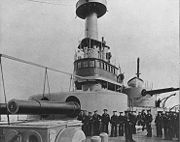
Indiana class battleship
The three Indiana-class battleships were the first battleships to be built by the United States Navy comparable to contemporary European ships, such as the British . Authorized in 1890 and commissioned between November 1895 and April 1896, they were relatively small battleships with heavy armor and...
, Iowa
USS Iowa (BB-4)
| The second half of the 19th century saw radical changes in shipbuilding design. Wood-built sailing ships with cannons were replaced by steam-powered warships armored with steel...
, and Kearsarge
Kearsarge class battleship
The Kearsarge class was a two-ship class of battleships built for the United States Navy at the beginning of the 20th century. Its first ship, the , was commissioned in 1900. The lead ship of this class, USS Kearsarge, was the only United States battleship not named for a state.- Ship history :This...
classes, but not in the battleships laid down between 1897 and 1901. Shortly after the USN re-adopted the intermediate battery, the British, Italian, Russian, French, and Japanese navies laid down intermediate-battery ships. This later generation of intermediate-battery ships almost without exception finished building after Dreadnought, and hence were obsolete before completion.
During the ironclad age, the range of engagements increased; in the Sino-Japanese War of 1894–5 battles were fought at around 1 mile (1,600 m), while in the Battle of the Yellow Sea
Battle of the Yellow Sea
The Battle of the Yellow Sea was a major naval engagement of the Russo-Japanese War, fought on 10 August 1904. In the Russian Navy, it was referred to as the Battle of 10 August. The battle foiled an attempt by the Russian fleet at Port Arthur to break out and form up with counterparts from...
in 1904, the Russian and Japanese fleets had opened fire at over 8 miles (12.8 km) before settling down to ranges at 3.5 miles (5,600 m). The increase in engagement range was due in part to the longer range of torpedoes, and in part to improved gunnery and fire control. In consequence, shipbuilders tended towards heavier secondary armament, of the same calibre that the "intermediate" battery had been previously; the Royal Navy's last pre-dreadnought class, the Lord Nelson
Lord Nelson class battleship
The Lord Nelson class was a two-ship class of pre-dreadnought battleships built by the Royal Navy between 1905 and 1908. Although they were the last British pre-dreadnoughts, both were completed and commissioned after HMS Dreadnought had entered service. and were serving in the Channel Fleet when...
class, carried ten 9.2-inch guns
BL 9.2 inch Mk XI naval gun
The BL 9.2 inch gun Mark XI was a British 50 calibre high-velocity naval gun which was mounted as primary armament on armoured cruisers and secondary armament on pre-dreadnought battleships.-History:...
as secondary armament. Ships with a uniform, heavy secondary battery are often referred to as "semi-dreadnoughts".
The pre-dreadnought's armament was completed by a tertiary battery of light, rapid-fire guns. These could be of any calibre from 3-inch (76 mm) down to machine gun
Machine gun
A machine gun is a fully automatic mounted or portable firearm, usually designed to fire rounds in quick succession from an ammunition belt or large-capacity magazine, typically at a rate of several hundred rounds per minute....
s. Their role was to give short-range protection against torpedo boats, or to rake the deck and superstructure of a battleship.
In addition to their gun armament, many pre-dreadnought battleships were armed with torpedoes, fired from fixed tubes located either above or below the waterline. By the pre-dreadnought era the torpedo was typically 18 inches (46 cm) in diameter and had an effective range of several thousand yards. However, it was virtually unknown for a battleship to score a hit with a torpedo.
Protection
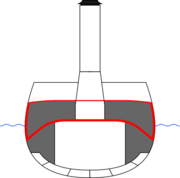
Barbette
A barbette is a protective circular armour feature around a cannon or heavy artillery gun. The name comes from the French phrase en barbette referring to the practice of firing a field gun over a parapet rather than through an opening . The former gives better angles of fire but less protection...
s to an all-enclosed, turret mounting.
The main belt armour would normally taper to a lesser thickness along the side of the hull towards bow and stern; it might also taper up from the central citadel towards the superstructure. The deck was typically lightly armoured with 2 to 4 inches of steel. This lighter armour was to prevent high-explosive shells from wrecking the superstructure of the ship.
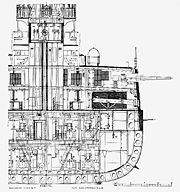
Royal Sovereign class battleship
The Royal Sovereign class was a class of pre-dreadnought battleships of the British Royal Navy. The class comprised seven ships built to the same design: HMS Royal Sovereign, , HMS Ramilles, HMS Repulse, HMS Resolution, HMS Revenge, and HMS Royal Oak, and a half-sister built to a modified design: ....
, were armoured with iron and steel compound armour
Compound armour
Compound armour was a type of armour used on warships in the 1880s. By the end of the decade it had been rendered obsolete by nickel-steel armour.-Prior armours:...
. This was soon replaced with more effective case-hardened steel armour made using the Harvey process
Harvey armor
Harvey armor was a type of steel armor developed in the early 1890s in which the front surfaces of the plates were case hardened. The method for doing this was known as the Harvey process....
developed in the United States. First tested in 1891, Harvey armour was commonplace in ships laid down in 1893–5. However, its reign was brief; in 1895, the German Kaiser Friedrich III
SMS Kaiser Friedrich III
SMS Kaiser Friedrich III was the lead ship of the Kaiser Friedrich III class of pre-dreadnought battleships. She was laid down at the Kaiserliche Werft in Wilhelmshaven in 1895, and finished in October 1898...
pioneered the even better Krupp armour
Krupp armour
Krupp armour was a type of steel armour used in the construction of capital ships starting shortly before the end of the 19th century. It was developed by Germany's Krupp Arms Works in 1893 and quickly replaced Harvey armour as the primary method of protecting naval ships.The initial manufacturing...
. Europe adopted Krupp plate within five years, and only the United States persisted in using Harvey steel into the 20th century. The improving quality of armour plate meant that new ships could have better protection from a thinner and lighter armour belt; 12 inches (305 mm) of compound armour provided the same protection as just 7.5 inches (190 mm) of Harvey or 5.75 inches (133 mm) of Krupp.
Propulsion
Almost all pre-dreadnoughts were powered by reciprocating steam engineSteam engine
A steam engine is a heat engine that performs mechanical work using steam as its working fluid.Steam engines are external combustion engines, where the working fluid is separate from the combustion products. Non-combustion heat sources such as solar power, nuclear power or geothermal energy may be...
s. Most were capable of top speeds between 16 and 18 kn (22 mph; 35 km/h). The ironclads of the 1880s used compound engines, and by the end of the 1880s the even-more efficient triple expansion compound engine was in use. Some fleets, though not the British, adopted the quadruple-expansion steam engine.
The main improvement in engine performance during the pre-dreadnought period came from the adoption of increasingly higher pressure steam from the boiler. Scotch marine boiler
Scotch marine boiler
A "Scotch" marine boiler is a design of steam boiler best known for its used on ships.The general layout is that of a squat horizontal cylinder. One or more large cylindrical furnaces are in the lower part of the boiler shell. Above this is a large number of small-diameter fire-tubes...
s were superseded by more compact water-tube boiler
Water-tube boiler
A water tube boiler is a type of boiler in which water circulates in tubes heated externally by the fire. Fuel is burned inside the furnace, creating hot gas which heats water in the steam-generating tubes...
s, allowing higher-pressure steam to be produced with less fuel consumption. Water-tube boilers were also safer, with less risk of explosion, and more flexible than fire-tube types. The Belleville-type water-tube boiler had been introduced in the French fleet as early as 1879, but it took until 1894 for the Royal Navy to adopt it for armoured cruisers and pre-dreadnoughts; other water-tube boilers followed in navies worldwide.

Turbine
A turbine is a rotary engine that extracts energy from a fluid flow and converts it into useful work.The simplest turbines have one moving part, a rotor assembly, which is a shaft or drum with blades attached. Moving fluid acts on the blades, or the blades react to the flow, so that they move and...
powered Pre-Dreadnought battleships, the Danton class
Danton class battleship
The Danton class was a class of French battleships built between 1907–1911, which served in World War I. The six ships in the class were all pre-dreadnought battleships, the last of their kind produced in the French Navy.-Design and production:...
of 1907.
Coal was the almost exclusive fuel for the pre-dreadnought period, though navies made the first experiments with oil propulsion in the late 1890s. An extra knot or two of speed could be gained by applying a 'forced draught' to the furnaces, where air was pumped into the furnaces, but this risked damage to the boilers.
Pre-dreadnought fleets and battles
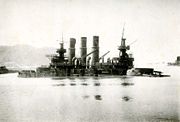
Cruiser
A cruiser is a type of warship. The term has been in use for several hundreds of years, and has had different meanings throughout this period...
s of many descriptions: modern armoured cruiser
Armored cruiser
The armored cruiser was a type of warship of the late 19th and early 20th centuries. Like other types of cruiser, the armored cruiser was a long-range, independent warship, capable of defeating any ship apart from a battleship, and fast enough to outrun any battleships it encountered.The first...
s which were essentially cut-down battleships, lighter protected cruiser
Protected cruiser
The protected cruiser is a type of naval cruiser of the late 19th century, so known because its armoured deck offered protection for vital machine spaces from shrapnel caused by exploding shells above...
s, and even older unarmoured cruisers, sloops and frigates whether built out of steel, iron or wood. The battleships were threatened by torpedo boat
Torpedo boat
A torpedo boat is a relatively small and fast naval vessel designed to carry torpedoes into battle. The first designs rammed enemy ships with explosive spar torpedoes, and later designs launched self-propelled Whitehead torpedoes. They were created to counter battleships and other large, slow and...
s; it was during the pre-dreadnought era that the first destroyer
Destroyer
In naval terminology, a destroyer is a fast and maneuverable yet long-endurance warship intended to escort larger vessels in a fleet, convoy or battle group and defend them against smaller, powerful, short-range attackers. Destroyers, originally called torpedo-boat destroyers in 1892, evolved from...
s were constructed to deal with the torpedo-boat threat, though at the same time the first effective submarine
Submarine
A submarine is a watercraft capable of independent operation below the surface of the water. It differs from a submersible, which has more limited underwater capability...
s were being constructed.
The pre-dreadnought age saw the beginning of the end of the 19th century naval balance of power in which France and Russia vied for competition against the massive British Royal Navy
Royal Navy
The Royal Navy is the naval warfare service branch of the British Armed Forces. Founded in the 16th century, it is the oldest service branch and is known as the Senior Service...
, and saw the start of the rise of the 'new naval powers' of Germany, Japan and the USA. The new ships of the Imperial Japanese Navy
Imperial Japanese Navy
The Imperial Japanese Navy was the navy of the Empire of Japan from 1869 until 1947, when it was dissolved following Japan's constitutional renunciation of the use of force as a means of settling international disputes...
and to a lesser extent the U.S. Navy supported those powers' colonial expansion.
While pre-dreadnoughts were adopted worldwide, there were no clashes between pre-dreadnought battleships until the very end of their period of dominance. The First Sino-Japanese War
First Sino-Japanese War
The First Sino-Japanese War was fought between Qing Dynasty China and Meiji Japan, primarily over control of Korea...
in 1894–95 influenced pre-dreadnought development, but this had been a clash between Chinese battleships and a Japanese fleet consisting of mostly cruisers. The Spanish-American War
Spanish-American War
The Spanish–American War was a conflict in 1898 between Spain and the United States, effectively the result of American intervention in the ongoing Cuban War of Independence...
of 1898 was also a mismatch, with the American pre-dreadnought fleet engaging Spanish cruisers. Not until the Russo-Japanese War
Russo-Japanese War
The Russo-Japanese War was "the first great war of the 20th century." It grew out of rival imperial ambitions of the Russian Empire and Japanese Empire over Manchuria and Korea...
of 1904–05 did pre-dreadnoughts engage on an equal footing. This happened in three battles: the Russian tactical victory during the Battle of Port Arthur
Battle of Port Arthur
The Battle of Port Arthur was the starting battle of the Russo-Japanese War...
on 8–9 February 1904, the indecisive Battle of the Yellow Sea
Battle of the Yellow Sea
The Battle of the Yellow Sea was a major naval engagement of the Russo-Japanese War, fought on 10 August 1904. In the Russian Navy, it was referred to as the Battle of 10 August. The battle foiled an attempt by the Russian fleet at Port Arthur to break out and form up with counterparts from...
on 10 August 1904, and the decisive Japanese victory at the Battle of Tsushima
Battle of Tsushima
The Battle of Tsushima , commonly known as the “Sea of Japan Naval Battle” in Japan and the “Battle of Tsushima Strait”, was the major naval battle fought between Russia and Japan during the Russo-Japanese War...
on 27 May 1905.
Gunboat diplomacy
Gunboat diplomacy
In international politics, gunboat diplomacy refers to the pursuit of foreign policy objectives with the aid of conspicuous displays of military power — implying or constituting a direct threat of warfare, should terms not be agreeable to the superior force....
was typically conducted by cruisers or smaller warships. A British squadron of three protected cruisers and two gunboats brought about the capitulation of Zanzibar
Anglo-Zanzibar War
The Anglo-Zanzibar War was fought between the United Kingdom and Zanzibar on 27 August 1896. The conflict lasted 38 minutes and is the shortest war in history. The immediate cause of the war was the death of the pro-British Sultan Hamad bin Thuwaini on 25 August 1896 and the subsequent succession...
in 1896; and while battleships participated in the combined fleet Western powers deployed during the Boxer rebellion
Boxer Rebellion
The Boxer Rebellion, also called the Boxer Uprising by some historians or the Righteous Harmony Society Movement in northern China, was a proto-nationalist movement by the "Righteous Harmony Society" , or "Righteous Fists of Harmony" or "Society of Righteous and Harmonious Fists" , in China between...
, the naval part of the action was performed by gunboats, destroyers and sloops.
Europe

Royal Navy
The Royal Navy is the naval warfare service branch of the British Armed Forces. Founded in the 16th century, it is the oldest service branch and is known as the Senior Service...
remained the world's largest fleet, though both Britain's traditional naval rivals and the new European powers increasingly asserted themselves against its supremacy.

Royal Sovereign class battleship
The Royal Sovereign class was a class of pre-dreadnought battleships of the British Royal Navy. The class comprised seven ships built to the same design: HMS Royal Sovereign, , HMS Ramilles, HMS Repulse, HMS Resolution, HMS Revenge, and HMS Royal Oak, and a half-sister built to a modified design: ....
and Majestic class
Majestic class battleship
The Majestic class was a class of pre-dreadnought battleships, built under the Spencer Programme of 8 December 1893, that sought to counter the growing naval strength of France and the Russian Empire...
were followed by a regular programme of construction at a much quicker pace than in previous years. The Canopus
Canopus class battleship
The Canopus class was a group of six pre-dreadnought battleships of the Royal Navy which were designed by Sir William White for use in the Far East and entered service between 1899 and 1902. The lead ship was which was followed by , , , and...
, Formidable
Formidable class battleship
The Royal Navy's Formidable class battleships was an eight-ship class of pre-dreadnoughts designed by Sir William White and built in the late 1890s...
, Duncan and King Edward VII
King Edward VII class battleship
The King Edward VII class was a class of pre-dreadnought battleships launched by the Royal Navy between 1903 and 1905.-Armament:By 1901, the 29 British battleships of the Majestic, Canopus, Formidable, London, Queen, and Duncan classes then in service or under construction, all following the same...
classes appeared in rapid succession from 1897 to 1905. Counting two ships ordered by Chile but taken over by the British, the Royal Navy had 39 pre-dreadnought battleships ready or building by 1904, starting the count from the Majestics. Over two dozen older battleships remained in service. The last British pre-dreadnoughts, the Lord Nelson class
Lord Nelson class battleship
The Lord Nelson class was a two-ship class of pre-dreadnought battleships built by the Royal Navy between 1905 and 1908. Although they were the last British pre-dreadnoughts, both were completed and commissioned after HMS Dreadnought had entered service. and were serving in the Channel Fleet when...
, appeared after Dreadnought herself.
France, Britain's traditional naval rival, had paused its battleship building during the 1880s because of the influence of the Jeune Ecole
Jeune Ecole
The Jeune École was a strategic naval concept developed during the 19th century. It advocated the use of small, powerfully equipped units to combat a larger battleship fleet, and commerce raiders capable of ending the trade of the rival nation...
doctrine, which favoured torpedo boat
Torpedo boat
A torpedo boat is a relatively small and fast naval vessel designed to carry torpedoes into battle. The first designs rammed enemy ships with explosive spar torpedoes, and later designs launched self-propelled Whitehead torpedoes. They were created to counter battleships and other large, slow and...
s to battleships. After the Jeune Ecole's influence faded, the first French battleship laid down was Brennus
French battleship Brennus (1891)
The Brennus was an ironclad battleship of the French Navy.She was built after the Jeune École trend of thought fell out of favour. She pioneered the armoured masts fitted with electrical elevators to the tops which became a trademark of French battleships.-Construction:The decision to fit Brennus...
, in 1889. Brennus and the ships which followed her were individual, as opposed to the large classes of British ships; they also carried an idiosyncratic arrangement of heavy guns, with Brennus carrying three 13.4 inches (340 mm) guns and the ships which followed carrying two 12-inch and two 10.8-inch in single turrets. The Charlemagne class
Charlemagne class battleship
The Charlemagne class was a class of pre-dreadnought battleships of the French Navy. It consisted of three ships, the Charlemagne, the St Louis and the Gaulois. Several other single ship classes were based on the Charlemagne class...
, laid down 1894–96, were the first to adopt the standard four 12 inches (305 mm) gun heavy armament. The Jeune Ecole retained a strong influence on French naval strategy, and by the end of the 19th century France had abandoned competition with Britain in battleship numbers. The French suffered the most from the Dreadnought revolution, with four ships of the Liberté class
Liberté class battleship
The Liberté class was a class of pre-dreadnought battleships of the French Navy, an improvement of the République-class battleship of a similar design.-Design and History:...
still building when Dreadnought launched, and a further six of the Danton class
Danton class battleship
The Danton class was a class of French battleships built between 1907–1911, which served in World War I. The six ships in the class were all pre-dreadnought battleships, the last of their kind produced in the French Navy.-Design and production:...
begun afterwards.
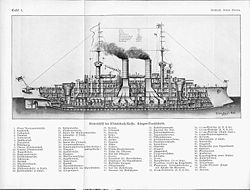
Brandenburg class battleship
The four Brandenburg-class pre-dreadnought battleships were Germany's first ocean-going battleships. They were also the first German warship, of any type, to be fitted with wireless communications. The class comprised , , , and . All were laid down in 1890 and completed by 1893, except for...
, were laid down in 1890. By 1905, a further 19 battleships were built or under construction, thanks to the sharp increase in naval expenditure justified by the 1898 and 1900 Navy Laws
Fleet Acts
The Naval Laws were five separate laws passed by the German Empire, in 1898, 1900, 1906, 1908, and 1912. These acts, championed by Kaiser Wilhelm II and his Secretary of State for the Navy, Grand Admiral Alfred von Tirpitz, committed Germany to building up a navy capable of competing with the Royal...
. This increase was due to the determination of the navy chief Alfred von Tirpitz
Alfred von Tirpitz
Alfred von Tirpitz was a German Admiral, Secretary of State of the German Imperial Naval Office, the powerful administrative branch of the German Imperial Navy from 1897 until 1916. Prussia never had a major navy, nor did the other German states before the German Empire was formed in 1871...
and the growing sense of national rivalry with the UK. Besides the Brandenburg class, German pre-dreadnoughts include the ships of the Kaiser Friedrich III
Kaiser Friedrich III class battleship
Kaiser Friedrich III class battleships were a class of pre–World War I, pre-dreadnought battleships of the German Kaiserliche Marine. The class was made up of five ships, all of which were named for German emperors...
, Wittelsbach
Wittelsbach class battleship
The Wittelsbach-class battleships were a group of five pre-dreadnought battleships of the German Kaiserliche Marine . They were the first battleships produced under the Navy Law of 1898. The class was composed of the lead ship, , , , and . All five ships were laid down between 1899 and 1900, and...
, and Braunschweig
Braunschweig class battleship
The Braunschweig class battleships were pre-dreadnought battleships of the Kaiserliche Marine . The class comprised five ships: , , , , and...
classes—culminating in the Deutschland class
Deutschland class battleship
The Deutschland class was a group of five pre-dreadnought battleships built for the German Kaiserliche Marine. The class comprised , , , , and . Built between 1903 and 1908, the ships closely resembled those of the preceding , though they had stronger armor protection...
, which served in both World Wars. On the whole, the German ships were less powerful than their British equivalents but equally robust.
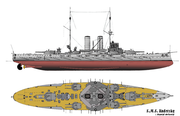
Petropavlovsk class battleship (1897)
The Petropavlovsk-class were pre-dreadnought battleships built for the Imperial Russian Navy. All three ships fought and were lost in the Russo-Japanese war. Two ships were destroyed and one was captured by the Japanese....
begun in 1892 took after the British Royal Sovereign
Royal Sovereign class battleship
The Royal Sovereign class was a class of pre-dreadnought battleships of the British Royal Navy. The class comprised seven ships built to the same design: HMS Royal Sovereign, , HMS Ramilles, HMS Repulse, HMS Resolution, HMS Revenge, and HMS Royal Oak, and a half-sister built to a modified design: ....
s; later ships showed more French influence on their design, such as the Borodino-class
Borodino class battleship
The five Borodino-class battleships were pre-dreadnoughts built between 1899 and 1905 for the Imperial Russian Navy...
. The weakness of Russian shipbuilding meant that many ships were built overseas for Russia; the best ship, the Retvizan
Russian battleship Retvizan
Retvizan was a Russian pre-dreadnought battleship built before the Russo-Japanese War of 1904–05 for the Imperial Russian Navy in the United States. She was built by the William Cramp and Sons Ship & Engine Building Company of Philadelphia, although the armament was made at the Obukhov works in...
, being largely constructed in America. The Russo-Japanese War
Russo-Japanese War
The Russo-Japanese War was "the first great war of the 20th century." It grew out of rival imperial ambitions of the Russian Empire and Japanese Empire over Manchuria and Korea...
of 1904–05 was a disaster for the Russian pre-dreadnoughts; of the 15 battleships completed since Petropavlovsk, eleven were sunk or captured during the war. One of these, the famous Potemkin
Russian battleship Potemkin
The Potemkin was a pre-dreadnought battleship of the Imperial Russian Navy's Black Sea Fleet. The ship was made famous by the Battleship Potemkin uprising, a rebellion of the crew against their oppressive officers in June 1905...
, mutinied and was scuttled, however she was later raised and recommissioned. After the war, Russia completed four more pre-dreadnoughts after 1905.
Between 1893 and 1904, Italy laid down eight battleships; the later two classes of ship were remarkably fast, though the Regina Margherita class was poorly protected and the Regina Elena class lightly armed. In some ways, these ships presaged the concept of the battlecruiser
Battlecruiser
Battlecruisers were large capital ships built in the first half of the 20th century. They were developed in the first decade of the century as the successor to the armoured cruiser, but their evolution was more closely linked to that of the dreadnought battleship...
. The Austro-Hungarian Empire also saw a naval renaissance during the 1890s, though of the nine pre-dreadnought battleships ordered only the three of the Habsburg class arrived before Dreadnought herself made them obsolete.
America and the Pacific
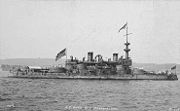
HMS Hood (1891)
The second warship to be named HMS Hood was a modified Royal Sovereign-class battleship of the Royal Navy, and the last of the eight built. She differed from the Royal Sovereign class in that she had cylindrical gun turrets instead of barbettes, a lower freeboard and a higher metacentric height...
except for an innovative intermediate battery of 8-inch guns. The US Navy continued to build ships that were relatively short-range and poor in heavy seas, until the Virginia class
Virginia class battleship
The Virginia class battleship was designed to be the first truly seagoing U.S. battleships. Five ships were commissioned between 1906 and 1907. The ships participated in the round-the-world cruise of the Great White Fleet. For the second and last time, the U.S...
laid down in 1901–02. Nevertheless, it was these earlier ships that ensured American naval dominance against the antiquated Spanish fleet—which included no pre-dreadnoughts—in the Spanish-American War
Spanish-American War
The Spanish–American War was a conflict in 1898 between Spain and the United States, effectively the result of American intervention in the ongoing Cuban War of Independence...
, most notably at Battle of Santiago de Cuba
Battle of Santiago de Cuba
The Battle of Santiago de Cuba, fought between Spain and the United States on 3 July 1898, was the largest naval engagement of the Spanish-American War and resulted in the destruction of the Spanish Navy's Caribbean Squadron.-Spanish Fleet:...
. The final two classes of American pre-dreadnoughts (the Connecticuts
Connecticut class battleship
- External links :...
and Mississippis
Mississippi class battleship
The Mississippi class of battleships comprised two ships which were authorized in the 1903 naval budget: and . They were the last pre-dreadnought battleships to be designed for the United States Navy; however, they were not the last to be built as one more ship of a prior design was completed...
) were completed after the completion of the Dreadnought and after the start of design work on the USN's own initial class of dreadnoughts. The US Great White Fleet
Great White Fleet
The Great White Fleet was the popular nickname for the United States Navy battle fleet that completed a circumnavigation of the globe from 16 December 1907 to 22 February 1909 by order of U.S. President Theodore Roosevelt. It consisted of 16 battleships divided into two squadrons, along with...
of 16 pre-dreadnought battleships circumnavigated the world from 16 December 1907, to 22 February 1909.

Japanese battleship Fuji
-External links:*...
, were still being built at the outbreak of the First Sino-Japanese War
First Sino-Japanese War
The First Sino-Japanese War was fought between Qing Dynasty China and Meiji Japan, primarily over control of Korea...
of 1894–95, which saw Japanese armoured cruisers and protected cruiser
Protected cruiser
The protected cruiser is a type of naval cruiser of the late 19th century, so known because its armoured deck offered protection for vital machine spaces from shrapnel caused by exploding shells above...
s defeat the Chinese Beiyang Fleet
Beiyang Fleet
The Beiyang Fleet was one of the four modernised Chinese navies in the late Qing Dynasty. Among the four, the Beiyang Fleet was particularly sponsored by Li Hongzhang, one of the most trusted vassals of Empress Dowager Cixi and the principal patron of the "self-strengthening movement" in northern...
, composed of a mixture of old ironclad battleships and cruisers, at the Battle of the Yalu River. Following their victory, and facing Russian pressure in the region, the Japanese placed orders for four more pre-dreadnoughts; along with the two Fujis these battleships formed the core of the fleet which twice engaged the numerically superior Russian fleets at the Battle of the Yellow Sea
Battle of the Yellow Sea
The Battle of the Yellow Sea was a major naval engagement of the Russo-Japanese War, fought on 10 August 1904. In the Russian Navy, it was referred to as the Battle of 10 August. The battle foiled an attempt by the Russian fleet at Port Arthur to break out and form up with counterparts from...
and the Battle of Tsushima
Battle of Tsushima
The Battle of Tsushima , commonly known as the “Sea of Japan Naval Battle” in Japan and the “Battle of Tsushima Strait”, was the major naval battle fought between Russia and Japan during the Russo-Japanese War...
. After capturing eight Russian battleships of various ages, Japan built several more classes of pre-dreadnought after the Russo-Japanese War.
Obsolescence

HMS Dreadnought (1906)
HMS Dreadnought was a battleship of the British Royal Navy that revolutionised naval power. Her entry into service in 1906 represented such a marked advance in naval technology that her name came to be associated with an entire generation of battleships, the "dreadnoughts", as well as the class of...
brought about the obsolescence of all existing battleships. Dreadnought, by scrapping the secondary battery, was able to carry ten 12 inches (305 mm) guns rather than four. She could fire eight heavy guns broadside, as opposed to four from a pre-dreadnought; and six guns ahead, as opposed to two. The move to an 'all-big-gun' design was a logical conclusion of the increasingly long engagement ranges and heavier secondary batteries of the last pre-dreadnoughts; Japan and the USA had designed ships with a similar armament before Dreadnought, but were unable to complete them before the British ship. It was felt that only the largest guns were effective in battle, and by mounting more 12-inch guns Dreadnought was two to three times more effective in combat than an existing battleship.
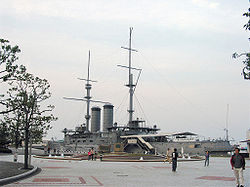
Steam turbine
A steam turbine is a mechanical device that extracts thermal energy from pressurized steam, and converts it into rotary motion. Its modern manifestation was invented by Sir Charles Parsons in 1884....
s for propulsion, giving her a top speed of 21 knots, against the 18 knots typical of the pre-dreadnought battleships. Able both to outgun and outmaneuver their opponents, the dreadnought battleships
Dreadnought
The dreadnought was the predominant type of 20th-century battleship. The first of the kind, the Royal Navy's had such an impact when launched in 1906 that similar battleships built after her were referred to as "dreadnoughts", and earlier battleships became known as pre-dreadnoughts...
decisively outclassed earlier battleship designs.
Nevertheless, pre-dreadnoughts continued in active service and saw significant combat use even when obsolete. Dreadnoughts and battlecruisers were believed vital for the decisive naval battles which at the time all nations expected, hence were jealously guarded against the risk of damage by mines or submarine attack, and kept close to home as much as possible. The obsolescence and consequent expendability of the pre-dreadnoughts meant that they could be deployed into more dangerous situations and more far-flung areas.
The only pre-dreadnought preserved today is the Japanese Navy's flagship at the Battle of Tsushima
Battle of Tsushima
The Battle of Tsushima , commonly known as the “Sea of Japan Naval Battle” in Japan and the “Battle of Tsushima Strait”, was the major naval battle fought between Russia and Japan during the Russo-Japanese War...
, the Mikasa
Japanese battleship Mikasa
is a pre-Dreadnought battleship of the Imperial Japanese Navy, launched in Britain in 1900. She served as the flagship of Admiral Tōgō Heihachirō during the Battle of the Yellow Sea on 10 August 1904, and the Battle of Tsushima on 27 May 1905 during the Russo-Japanese War. The ship is preserved as...
, which is now located in Yokosuka, where it has been a museum ship since 1925.
World War I

This was first illustrated in the skirmishes between British and German navies around South America in late autumn 1914. As two German cruisers menaced British shipping, the Admiralty insisted that no battlecruisers could be spared from the main fleet and sent to the other side of the world to deal with them. Instead the British dispatched a pre-dreadnought of 1896 vintage, HMS Canopus. Intended to stiffen the British cruisers in the area, in fact her slow speed meant that she was left behind at the disastrous Battle of Coronel
Battle of Coronel
The First World War naval Battle of Coronel took place on 1 November 1914 off the coast of central Chile near the city of Coronel. German Kaiserliche Marine forces led by Vice-Admiral Graf Maximilian von Spee met and defeated a Royal Navy squadron commanded by Rear-Admiral Sir Christopher...
. Canopus redeemed herself at the Battle of the Falkland Islands
Battle of the Falkland Islands
The Battle of the Falkland Islands was a British naval victory over the Imperial German Navy on 8 December 1914 during the First World War in the South Atlantic...
, but only when grounded to act as a harbour-defence vessel; she fired at extreme range (13,500 yards) on the German cruiser SMS Gneisenau
SMS Gneisenau
SMS Gneisenau was an armored cruiser of the German navy, part of the two-ship . She was named after August von Gneisenau, a Prussian general of the Napoleonic Wars. The ship was laid down in 1904 at the AG Weser dockyard in Bremen, launched in June 1906, and completed in March 1908, at a cost of...
, and while the only hit was from an inert practice shell which had been left loaded from the previous night (the 'live' shells of the salvo broke up on contact with water; one inert shell ricocheted into one of Gneisenaus funnels), this certainly deterred Gneisenau from a potentially damaging raid on a British squadron which was still taking on coal. The subsequent battle was decided by the two Invincible-class battlecruisers
Invincible class battlecruiser
The three Invincible class battlecruisers were built for the Royal Navy and entered service in 1908 as the world's first battlecruisers. They were the brainchild of Admiral Sir John Fisher, the man who had sponsored the construction of the world's first "all big gun" warship,...
which had been dispatched after Coronel. This appears to have been the only meaningful engagement of an enemy ship by a British pre-dreadnought.
In the Black Sea five Russian pre-dreadnoughts saw brief action against the Ottoman battlecruiser Yavuz during the Battle of Cape Sarych
Battle of Cape Sarych
The Battle of Cape Sarych was a naval engagement fought off the coast of Cape Sarych during the First World War. In November 1914, two modern Ottoman warships, a light cruiser and a battlecruiser, under the German Admiral Wilhelm Souchon engaged a Russian fleet including 5 obsolescent...
in November 1914.
The principle that disposable pre-dreadnoughts could be used where no modern ship could be risked was affirmed by British, French and German navies in subsidiary theatres of war. The German navy used its pre-dreadnoughts frequently in the Baltic campaign. However, the largest number of pre-dreadnoughts was engaged at the Gallipoli
Battle of Gallipoli
The Gallipoli Campaign, also known as the Dardanelles Campaign or the Battle of Gallipoli, took place at the peninsula of Gallipoli in the Ottoman Empire between 25 April 1915 and 9 January 1916, during the First World War...
campaign. Twelve British and French pre-dreadnoughts formed the bulk of the force which attempted to 'force the Dardanelles
Naval operations in the Dardanelles Campaign
The naval operations in the Dardanelles Campaign of the First World War were mainly carried out by the Royal Navy with substantial support from the French and minor contributions from Russia and Australia. The Dardanelles Campaign began as a purely naval operation...
' in March 1915. The role of the pre-dreadnoughts was to support the brand-new dreadnought Queen Elizabeth
HMS Queen Elizabeth (1913)
HMS Queen Elizabeth was the lead ship of the Queen Elizabeth-class of dreadnought battleships, named in honour of Elizabeth I of England. She saw service in both World Wars...
engaging the Turkish shore defences. Three of the pre-dreadnoughts were sunk by mines, and several more badly damaged. However, it was not the damage to the pre-dreadnoughts which led to the operation being called off. The two battlecruisers were also damaged; since Queen Elizabeth could not be risked in the minefield, and the pre-dreadnoughts would be unable to deal with the Turkish battlecruiser lurking on the other side of the straits, the operation had failed. Pre-dreadnoughts were also used to support the Gallipoli landings, with the loss of three more: Goliath
HMS Goliath (1898)
HMS Goliath was one of the six Canopus-class pre-dreadnought battleships built by the Royal Navy in the late 19th century. In the First World War Goliath took part in the blockade of the German light cruiser in the Rufiji River but unsuccessful to bombard the cruiser in the delta.On 13 May 1915...
, Triumph
HMS Triumph (1903)
HMS Triumph was a Swiftsure class pre-dreadnought battleship of the Royal Navy.-Technical characteristics:HMS Triumph was ordered by Chile as Libertad, laid down by Vickers at Barrow-in-Furness on 26 February 1902, and launched on 12 January 1903...
and Majestic
HMS Majestic (1895)
HMS Majestic was a Majestic-class predreadnought battleship of the Royal Navy.-Technical characteristics:HMS Majestic was laid down at Portsmouth Dockyard on 5 February 1894 and launched on 31 January 1895...
.
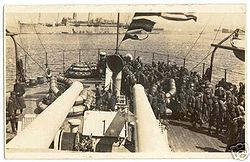
Battle of Jutland
The Battle of Jutland was a naval battle between the British Royal Navy's Grand Fleet and the Imperial German Navy's High Seas Fleet during the First World War. The battle was fought on 31 May and 1 June 1916 in the North Sea near Jutland, Denmark. It was the largest naval battle and the only...
in 1916; German sailors called them the "five minute ships", which was the amount of time they were expected to survive in a pitched battle. In spite of their limitations, the pre-dreadnought squadron played a useful role. As the German fleet disengaged from the battle, the pre-dreadnoughts risked themselves by turning on the British battlefleet as dark set. Nevertheless, only one of the pre-dreadnoughts was sunk: SMS Pommern
SMS Pommern
SMS Pommern was one of five Deutschland class of pre-dreadnought battleships built for the Kaiserliche Marine between 1904 and 1906. Named after the Prussian province of Pomerania, she was built at the AG Vulcan yard at Stettin, where she was laid down on 22 March 1904 and launched on 2 December...
went down in the confused night action as the battlefleets disengaged.
Following the November 1918 Armistice, the U.S. Navy converted fifteen older battleships, eight armoured cruisers and two larger protected cruisers for temporary service as transports. These ships made one to six trans-Atlantic round-trips each, bringing home a total of more than 145,000 passengers.
World War II
After World War I, most battleships, dreadnought and pre-dreadnought alike, were disarmed under the terms of the Washington Naval TreatyWashington Naval Treaty
The Washington Naval Treaty, also known as the Five-Power Treaty, was an attempt to cap and limit, and "prevent 'further' costly escalation" of the naval arms race that had begun after World War I between various International powers, each of which had significant naval fleets. The treaty was...
. Largely this meant the ships being broken up for scrap; others were destroyed in target practice or relegated to training and supply duties. One, Mikasa
Japanese battleship Mikasa
is a pre-Dreadnought battleship of the Imperial Japanese Navy, launched in Britain in 1900. She served as the flagship of Admiral Tōgō Heihachirō during the Battle of the Yellow Sea on 10 August 1904, and the Battle of Tsushima on 27 May 1905 during the Russo-Japanese War. The ship is preserved as...
, was given a special exemption to the Washington Treaty and was maintained as a museum
Museum ship
A museum ship, or sometimes memorial ship, is a ship that has been preserved and converted into a museum open to the public, for educational or memorial purposes...
and memorial ship.

German battleship Schleswig-Holstein
SMS Schleswig-Holstein, one of the five s, was the last pre-dreadnought battleship built by the German Kaiserliche Marine. The ship was laid down in the Germaniawerft dockyard in Kiel in August 1905 and commissioned into the fleet nearly three years later in July 1908...
, shelled the Polish Westerplatte
Westerplatte
Westerplatte is a peninsula in Gdańsk, Poland, located on the Baltic Sea coast mouth of the Dead Vistula , in the Gdańsk harbour channel...
peninsula during the opening of the German invasion of Poland. Schleswig-Holstein served for most of the War as a training ship; she was sunk while under refit in December 1944, and broken up in situ in January 1945. The other, Schlesien
German battleship Schlesien
SMS Schlesien was one of the five Deutschland class of pre-dreadnought battleships built for the Kaiserliche Marine between 1904 and 1906. Named after the German province of Schlesien, she was built at the Schichau-Werke shipyard in Danzig, where she was launched on 28 May 1906. She was...
, was mined and then scuttled in March 1945.
A number of the inactive or disarmed pre-dreadnoughts were nevertheless sunk in action during World War II, such as the Greek pre-dreadnoughts Kilkis
Greek Battleship Kilkis
Kilkis was a 13,000 ton Mississippi-class battleship originally built by the US Navy in 1904–1908. The Greek Navy purchased the ship in 1914, along with her sister , renamed Limnos. Kilkis was named for the Battle of Kilkis-Lahanas, a crucial engagement of the Second Balkan War...
and Limnos
Greek Battleship Limnos
Limnos, sometimes spelled Lemnos , was a 13,000 ton Mississippi-class Greek battleship named for a crucial naval battle of the First Balkan War.-History of the ship:...
, bought from the U.S. Navy in 1914. While neither of the ships was in active service, they were both sunk by German divebombers after the German invasion in 1941. In the Pacific, the U.S. Navy submarine USS Salmon
USS Salmon (SS-182)
USS Salmon was the lead ship of her class of submarine. She was the second ship of the United States Navy to be named for the salmon, a soft-finned, gamy fish which inhabits the coasts of America and Europe in northern latitudes and ascends rivers for the purpose of spawning.Her keel was laid down...
sank the disarmed Japanese pre-dreadnought Asahi
Japanese battleship Asahi
|-External links:***...
in May 1942. A veteran of Tsushima
Battle of Tsushima
The Battle of Tsushima , commonly known as the “Sea of Japan Naval Battle” in Japan and the “Battle of Tsushima Strait”, was the major naval battle fought between Russia and Japan during the Russo-Japanese War...
, she was serving as a repair-ship.
See also
- Ironclad warshipIronclad warshipAn ironclad was a steam-propelled warship in the early part of the second half of the 19th century, protected by iron or steel armor plates. The ironclad was developed as a result of the vulnerability of wooden warships to explosive or incendiary shells. The first ironclad battleship, La Gloire,...
- Dreadnought battleshipsDreadnoughtThe dreadnought was the predominant type of 20th-century battleship. The first of the kind, the Royal Navy's had such an impact when launched in 1906 that similar battleships built after her were referred to as "dreadnoughts", and earlier battleships became known as pre-dreadnoughts...
Sources
- Beeler, John, Birth of the Battleship: British Capital Ship Design 1870–1881. Caxton, London, 2003. ISBN 1-84067-534-9
- Burt, R. A., British Battleships 1889–1904 Annapolis, MD: Naval Institute Press, 1988. ISBN 0-87021-061-0.
- Chesneau, Roger (ed). Conway's All the World's Fighting Ships 1922–1946. London: Conway, 1980. ISBN 0-85177-146-7.
- Forczyk, Robert. Russian Battleship vs Japanese Battleship; Yellow Sea 1904–05. Osprey, 2009. ISBN 978-1-84603-330-8
- Gardiner, Robert and Lambert, AndrewAndrew LambertAndrew Lambert BA , MA, PhD, FRHistS is a British naval historian, who is currently Laughton Professor of Naval History in the Department of War Studies at King's College London.-Early life and education:...
Steam, Steel and Shellfire: The Steam Warship, 1815–1905. Conways, London, 2001, ISBN 0-7858-1413-2- Roberts, J. "The Pre-Dreadnought Age" in Gardiner Steam, Steel and Shellfire.
- Campbell, J. "Naval Armaments and Armour" in Gardiner Steam, Steel and Shellfire.
- Griffiths, D. "Warship Machinery" in Gardiner, Steam, Steel and Shellfire.
- Gardiner, Robert. The Eclipse of the Big Gun: The Warship 1906–45. Conways, London, 1992. ISBN 0-85177-607-8
- Sumrall, R. The Battleship and Battlecruiser in Gardiner Eclipse of the Big Gun.
- Hill, Robert War at Sea in the Ironclad Age. Cassell, London, 2000. ISBN 0-304-35273-X
- Jentschura Jung & Mickel, Warships of the Imperial Japanese Navy 1869–1946, ISBN 0-85368-151-1
- Keegan, J. The First World War. Pimlico, London, 1999. ISBN 0-7126-6645-1.
- Kennedy, Paul M. The Rise and Fall of British Naval Mastery. Macmillan, London, 1983. ISBN 0-333-35094-4.
- Lenton, H.T. German Warships of the Second World War. London:Macdonald and Jane's, 1975. ISBN 0-356-04661-3.
- Massie, Robert K. Dreadnought: Britain, Germany and the Coming of the Great War. Pimlico, London, 2004. ISBN 978-1-84413-528-8
- Massie, Robert K. Castles of Steel: Britain, Germany and the Winning of the Great War at Sea. Pimlico, London, 2005. ISBN 1-84413-411-3
- Sondhaus, Lawrence. Naval Warfare 1815–1914. Routledge, London, 2001. ISBN 0-415-21478-5

